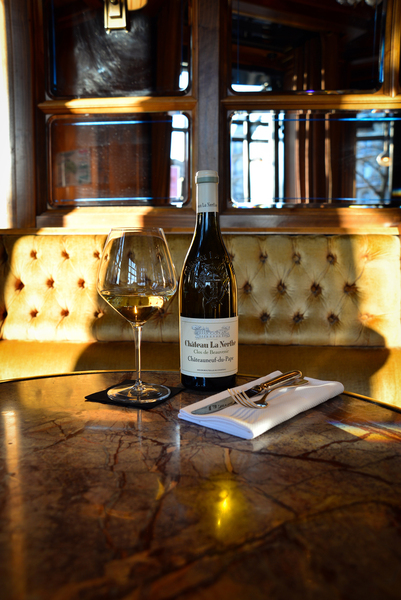
Which bottle to serve as a Christmas appetizer?
Among all the Christmas meal ideas, many include a refined appetizer. Foie gras is one of the classic staples. Whether cooked or semi-cooked, it forms a superb pairing with the Clos de Beauvenir 2023 from Château La Nerthe. This blend of Roussanne and Grenache Blanc from the Châteauneuf-du-Pape appellation is distinguished by its exceptional, infinitely elegant and deep personality. Its freshness and nectarine-like sweetness create a wonderfully balanced contrast with the richness and creaminess of foie gras. For a pan-fried version, opt for a fruity and supple red wine, such as the Le Perréon 2022 from Château de Corcelles.
Another festive classic is scallops, for example, enhanced by a topinambour cream with hazelnuts. To accompany this with style while surprising your guests, turn to a wine from Beaujolais, such as the Chardonnay 2023 from Château de Corcelles. Behind its pale golden hue, this white wine blends the minerality of its grape variety with the delicately wooded influence of barrel aging—perfect to complement the scallops.

What food and wine pairing to favor for the main course of a Christmas meal?
Christmas main courses, often generous and flavorful, call for wines that will magnify their intensity. For bold meats in sauce, such as game, the Cuvée des Cadettes 2020 from Château La Nerthe is the ideal companion. This Châteauneuf-du-Pape wine, dominated by Grenache Noir and complemented by Syrah and Mourvèdre, is both powerful, complex, and refined.
The Les Tours 2022 from Château des Tours, in the Brouilly appellation, also ensures a remarkable pairing. This 100% Gamay from Beaujolais is made from old vines perched on an amphitheater around the estate, releasing all their richness and concentration. With aromas of cassis and cherry, accented by subtle spicy notes, it combines complexity, balance, and indulgence.
However, if you prefer to serve a white meat to your guests, such as a roasted turkey with a butternut-hazelnut-parmesan crumble, let yourself be seduced by the Brouilly Les Roches 2021 from Château de Corcelles. This 100% Gamay boasts smooth tannins, nourished by a refined and persistent style. The Les Clavelles 2021 from Château La Nerthe, from an extraordinary plot of pure Grenache, is also a delightfully harmonious choice with its elegant density and the purity of its fruit.

Which wine to choose for Christmas at the cheese course ?
The cheese platter remains one of the most anticipated parts of the festive meal. Choosing the right wine for this key moment deserves special attention.
For white wine, opt for the Les Cassagnes de La Nerthe 2023, a Côtes-du-Rhône Blanc blending Viognier, Grenache Blanc, Roussanne, and Marsanne. This wine, reflecting its vineyard between Mediterranean forests and garrigue, is seduced by aromas of apricot, fresh pear, and white peach. Its citrusy mouth offers the ideal liveliness for enjoying fresh goat cheese. It also pairs beautifully with a young comté, whose firm texture and delicate aromas complement the wine’s freshness.
For a red wine and cheese pairing, head to Beaujolais with the Fleurie Poncié 2022 from Château de Corcelles, which invites you to a moment suspended between strength and finesse. Its mineral and undergrowth notes, along with dark fruit, elegantly unfold throughout a powerful yet refined mouthfeel. This wine pairs perfectly with a creamy brie, whose smooth texture and softness complement the richness of the Fleurie. You could also opt for a mild blue cheese like blue de Gex, whose creamy texture and slightly tangy flavor pair wonderfully with the fruity and mineral notes of the Fleurie.

Finally, which wine with a festive dessert?
The grand finale of the meal, dessert, adds a touch of indulgence to the Christmas dinner or Christmas Day lunch. And the chocolate Yule log often seems like an obvious choice. In this instance, the Château La Nerthe 2021 cuvée makes a lasting impression. This blend of Grenache Noir, Mourvèdre, Syrah, and Cinsault perfectly embodies the terroir of Châteauneuf-du-Pape. Its notes of ripe cherries and strawberries, enhanced by spicy touches, pair well with the richness of the chocolate, while its freshness and the subtlety of its tannins add a pleasant lightness.
In AOP Brouilly, the Combiaty 2020 from Château des Tours is also an excellent choice with its enticing concentration, expressive fruit, and the typical minerality of its appellation. For spirits enthusiasts, the Fine du Château La Nerthe (only available at the estate’s cellar) is a vintage eau-de-vie perfect for a chocolate Yule log, with its ample mouthfeel, dried fruit aromas, and a long, balanced finish.

From appetizers to desserts, you now know which wine to choose for Christmas. And if, after finalizing your menu, you still need to complete your gift list, our gift ideas for wine lovers are here to inspire you. Merry Christmas to you!
]]>
1. A selection of exceptional wines to place under your Christmas tree
Giving wine is a must for those who love oenology. But which wines should you choose for Christmas to make a difference?
The freshness and refinement of our Château La Nerthe’s organic-certified vintages stand out. These beautiful Châteauneuf-du-Pape wines, available in both red and white, can be ordered with just a few clicks from our online shop. Among them, some particularly prestigious bottles will delight even the most discerning wine lovers: our moving Cuvée des Cadettes, our iconic Clos de Beauvenir, and our rarest cuvée, Les Clavelles.
To round out your wine gift set, consider adding AOP Côtes-du-Rhône Villages and Côtes-du-Rhône wines, like Les Cassagnes de La Nerthe. The Beaujolais wines from our Château de Corcelles and Château des Tours offer more accessible options, with beautifully crafted expressions. These wines reveal different facets of the Beaujolais region, whether in Brouilly, Fleurie, Morgon, Beaujolais-Villages, or Beaujolais AOC. Their beautiful vineyard-specific selections invite you to travel through the great Beaujolais estates.
Finally, why not complete your Christmas wine selection with Bordeaux, Bordeaux Supérieur, Haut-Médoc Cru Bourgeois, or Côtes de Bourg AOC? Our Château Gantonnet, Château Victoria, Château Escalette, and Château de Barbe bottles are ideal choices.

2. A gift voucher for an unforgettable cellar tour to delight your loved ones
Among the most memorable Christmas gifts for wine lovers, a cellar tour ranks high. More than just a tasting, it’s a true immersion into a wine estate.
At Château La Nerthe, nestled in the heart of the Châteauneuf-du-Pape vineyards, our team offers three exceptional experiences: three suspended ways to taste five centuries of elegance, no matter the season, even in winter…
Each of these tours, which can be purchased as a gift voucher for Christmas, includes a discovery of the historical cellars of our château. You’ll just need to decide whether to complement this journey with a guided tasting of 5 or 7 wines, or even 8 exceptional cuvées from different vintages, in the candlelit ambiance of our secret cellar…

3. A historical wine tourism experience: a unique Christmas gift
If your loved ones plan to visit Beaujolais soon, this original gift idea will enchant them: a timeless experience at the impressive Château de Corcelles, with its distinctive 15th-century towers and expansive park.
There, they can enjoy an audio-guided tour of part of the château. You can also add to this discovery a guided tasting of 4 cuvées from our estate, with or without a delicious traditional mâchon, featuring cured meats and cheeses.
Additionally, an exclusive visit to the first floor of this historic monument, followed by a tasting of 5 wines, can be booked for those wanting to learn more about our château. The more adventurous guests can also explore our vineyards on a Segway before a well-deserved tasting…

4. A stay at the heart of the vineyard: a wine gift idea to share
For unforgettable memories with family or friends, nothing beats an oenology weekend or a prolonged wine-filled stay in a charming gîte in Beaujolais…
Our Château des Tours, located less than 50 km from Lyon and 40 km from Mâcon, is the perfect setting for such a getaway. In the Brouilly AOC, our estate offers two comfortable and elegant gîtes: our Gîte du Vigneron (open year-round) and our Gîte La Sarrasine (open from March to December). Both enjoy an idyllic location within a 12th-century architectural complex, surrounded by a sea of Beaujolais vineyards… This guarantees an extraordinary base for enjoying the wide range of oenological and cultural activities in the region!

We hope this selection of wine gift ideas will help you find the perfect gift for everyone on your list. For more inspiration, feel free to follow Château La Nerthe, Château de Corcelles, and Château des Tours on Instagram. Happy holidays!
]]>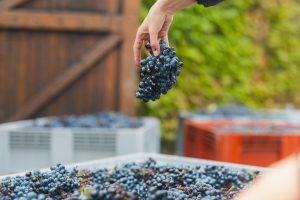
In the Rhône Valley, a Harvest Rich in Challenges and Promises
At Château La Nerthe, in the Châteauneuf-du-Pape and Côtes-du-Rhône appellations, our harvests involved several weeks of meticulous work. This year, more than ever, tested our teams in the vineyards as unpredictable, rainy weather demanded constant attention, especially given our commitment to organic viticulture since 1998.
Despite these challenging conditions, the 2024 vintage already stands out for its potential, both for our Châteauneuf-du-Pape and Côtes-du-Rhône wines. Thanks to the efforts of our teams and a more favorable September, we anticipate a fine reward in the bottle, which we eagerly await following the fermentation and aging of our wines.
At the Prieuré de Montézargues in the Tavel appellation, the observation is similar: although the yield was modest, the quality of the grapes was exceptional, promising excellent prospects for our Tavel rosé, an elegant, gastronomic wine…

In the Beaujolais Region, Grapes Promise a Quality 2024 Vintage
In the heart of Beaujolais, our Château des Tours and Château de Corcelles also saw a limited harvest volume. Nevertheless, we were delighted to see outstanding quality: the berries were healthy, ripe, and balanced, marking this vintage.
Both châteaux benefited from a superb August, which saved our grapes as the sunshine allowed each grape variety to reach ideal ripeness. Furthermore, our harvest teams enjoyed ideal working conditions, free from rain and extreme heat.
This emotional viticultural journey should yield refined and delicious wines for both the Brouilly wines of Château des Tours and the Fleurie, Morgon, Brouilly, and Beaujolais-Villages wines of Château de Corcelles.
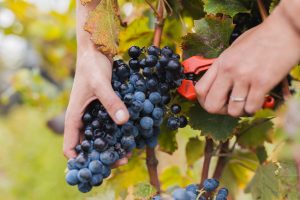
For Our Bordeaux Châteaux, a Harvest Hinting at Freshness
In our Bordeaux vineyards, including Château Gantonnet, Château Victoria, Château Escalette, and Château de Barbe, we also contended with a changing, unpredictable climate. Resilience was the watchword for our teams throughout the 2024 campaign.
We did our utmost to avoid harvesting in the rain to preserve grape quality and prevent water in our vats. To our surprise, yields were positive: despite a challenging year with disease pressure, especially in spring, the grapes remained healthy.
This vintage promises freshness, lovely fruit notes, and pleasing digestibility for the AOC Bordeaux and AOC Bordeaux Supérieur wines of Château Gantonnet, the AOC Haut-Médoc and Haut-Médoc Cru Bourgeois wines of Château Victoria, the AOC Côtes de Bourg cuvée from Château l’Escalette, and various Bordeaux appellations from Château de Barbe.

Once again, we extend our deepest thanks to all our harvest teams, who tirelessly accomplished remarkable work despite the whims of this vintage. Whether in the Rhône, Beaujolais, or Bordeaux, their precise and attentive efforts have been crucial in ensuring the best possible quality for this 2024 harvest. Join us in a few months or years to taste these wines from our estates and châteaux…


A Remarkable Year for Châteauneuf-du-Pape AOC
2023 will be remembered as an outstanding year for the Château La Nerthe vineyard in the Châteauneuf-du-Pape appellation. The mild winter, combined with dry weather, set a promising first step for the vintage. At the end of spring, the return of rain proved ideal for the flourishing of our vines. The summer was characterized by gentle warmth, causing only moderate water stress on the plants.
The exclusively manual harvest of our wonderfully high-quality grapes took place serenely until the end of September. For the first time, we were able to isolate 14 different lots of white grape varieties, enhancing the precision of our expertise in the vinification of our white wines.
The 25th Organic Vintage of Our Château

Since 1998, our estate has been committed to producing organic wines, a truly pioneering choice at the time in the Châteauneuf-du-Pape vineyards. 25 years later, these three bottles once again demonstrate our deep commitment to preserving our parcels and their precious biodiversity.
Our approach to organic farming includes regular studies to better understand our soils, the use of natural products such as herbal teas to strengthen the vines, and the planting of cover crops to protect the life of our land. But we do not hesitate to go further, combining viticulture and agroecology more broadly: shaping wines that fully embody the richness of their terroir.
The Three Exceptional 2023 White Wines of Château La Nerthe
Now available on our online store, with our partners, and for tasting at our château, these Châteauneuf-du-Pape and Côtes-du-Rhône wines reflect our excellent craftsmanship. Behind their luminous white robes, three unique personalities reveal themselves…
Château La Nerthe, Châteauneuf-du-Pape White 2023

This cuvée stands out for its strong personality and great freshness, sculpted by the benevolent microclimate enveloping our vines and the variety of soils where they take root. The tasting of this 2023 Châteauneuf-du-Pape white opens with a complex bouquet of citrus, fresh almond, and flowers such as honeysuckle and jasmine. Then, citrus and pear aromas delight the palate, leading to a long, refreshing finish with mentholated touches.
A blend of iconic Châteauneuf-du-Pape grape varieties (Roussanne, Grenache Blanc, Clairette, and Bourboulenc), this white wine forms a harmonious duo with fish such as a Provençal-style cod fillet: an intense experience to explore now or after a few more years of cellaring…
Clos de Beauvenir, Châteauneuf-du-Pape 2023

Our Clos de Beauvenir 2023 is a rare Châteauneuf-du-Pape white wine, born from an ancient garden of our vineyard. Here, the pebble-strewn soils surrounded by natural springs are the cradle of Roussanne and Grenache Blanc of infinite finesse, destined for several years of aging.
Through this wine, the 2023 vintage expresses all its elegance. The nose opens with fresh fruits (including white peach), accompanied by almond and hazelnut. Some mentholated, even smoky accents can also be detected. On the palate, the balance between freshness, sweetness, and depth testifies to a mastered aging process. It pairs perfectly with land and sea dishes, such as veal chop with morels or scallops.
Les Cassagnes de La Nerthe, Côtes-du-Rhône White 2023

The name of our cuvée Les Cassagnes de La Nerthe 2023 pays homage to the green oaks (“Cassagne” in Provençal) bordering its parcels. The blend of this Côtes-du-Rhône wine highlights Viognier, Grenache Blanc, Roussanne, and Marsanne.
Its nose is charming and delicate, with orchard fruits and floral nuances. This precedes a palate that is both lush and fresh, marked by lemon and vineyard peach. This captivating balance ends on a broad and deep finish, enhanced by a slight zesty bitterness: perfect for summer seafood dishes, like trout fillet with toasted almonds!
To taste these three fabulous expressions of the 2023 vintage from Château La Nerthe, our team is pleased to welcome you to our estate: a delicious oenological stopover during your visit to Châteauneuf-du-Pape…
]]>
An Idyllic Landscape as the Starting Point of Your Wine Tourism Experience

A memorable welcome starts with a carefully arranged arrival. Château La Nerthe leaves nothing to chance for your entrance to the estate. Less than 2 kilometers south of the village of Châteauneuf-du-Pape, a shaded alley lined with cypress trees, olive trees, and green oaks leads you to our refined 18th-century building.
Its terrace reveals itself as a peaceful haven in the Vaucluse, nestled in a marvelous park with majestic plane trees and century-old pines. Take the time to savor this breathtaking view of the Rhône Valley: to the east, Mont Ventoux, the highest peak in Vaucluse. In the distance, the outlines of the illustrious City of the Popes. In front of you, finally, our magnificent Châteauneuf-du-Pape vineyards, including our precious Clos de Beauvenir.
It is in this exceptional environment that our team is pleased to welcome you for a tour of our wine estate…
A Passionate Team to Share the Expertise of Château La Nerthe

This year, four individuals are here to let you touch five centuries of elegance at our Châteauneuf-du-Pape estate. They all share a profound sense of hospitality combined with an infinite passion for wine…
Antoine Olivain, a former handball player of 34 years, swapped balls for delicious bottles. After earning a master’s degree in international wine marketing in Avignon, he worked as a sommelier in Bali for five years and in New Zealand for one year. Antoine then joined the Christian Etienne establishment, the oldest Michelin-starred restaurant in Vaucluse, before becoming responsible for our private clientele.
Sylvie Chabran arrived at Château La Nerthe nearly 30 years ago and knows it inside out. Concurrently, she cultivated her love of wine for almost 26 years as a winemaker and manager of guesthouses: an obvious path for this woman from four generations of winemakers in the Côtes du Rhône and Vacqueyras, holding a technical diploma in viticulture-enology and a former board member of a cooperative winery. At 52, Sylvie gladly puts her thirst for travel, nature, and encounters at the service of your visits and tastings…
Alexis Kempf, a true product of our Châteauneuf-du-Pape terroir, is a genuine lover of good products and good friends. The 21-year-old young man turned to the wine world early on, joining the cooperative winery of the appellation during his BTS in commercial management. For the past year, he has made it a point of honor to convey with cheerfulness and clarity all the nuances of our expertise during each visit.
Thomas Camilleri, born in Avignon, completes our welcoming team for this 2024 season. A graduate with a bachelor’s degree in international business, he honed his skills as a sommelier at Christian Etienne, then as the Wine Tourism Manager of various estates in Provence-Alpes-Côte d’Azur, and as the Assistant General Manager of Monsieur Marcel Gourmet Market & Restaurant in Los Angeles.
Several Captivating Cellar Tour Options in Châteauneuf-du-Pape

Antoine, Sylvie, Alexis, and Thomas will be your guides to discover our Châteauneuf-du-Pape wines, which you can taste in our shop or during one of our three tour circuits. Bookable in a few clicks online or available as gift cards, these tours invite you to delve into the heart of our 16th-century historic cellars: carved under our Château, they have housed the patient aging of our bottles for over 500 years…
For one hour, the “Discovery” Experience offers a true overview of our estate, including a tour of our Châteauneuf-du-Pape cellar and a tasting of five of our wines, including the superb Cuvée des Cadettes.
The “Terroir” Experience opens with a guided tour retracing our history and various vineyard and cellar approaches. Then, seven of our wines are offered for tasting, including a rare old vintage, the emblematic Cuvée des Cadettes, and the mythical Clos de Beauvenir in white. Lasting 1.5 hours, this dive into our estate is truly fascinating.
The “Passion” Experience is a private 2-hour sensory journey, featuring a Châteauneuf-du-Pape tasting by candlelight in our secret cellar. Here, our sommelier introduces you to eight of our wines, including Les Clavelles, our most prestigious cuvée…
Whichever tour you choose, our team looks forward to welcoming you to Château La Nerthe to make your visit to Châteauneuf-du-Pape a suspended moment, both warm and refined…
]]>
In the heart of the prestigious AOC Châteauneuf-du-Pape, Château La Nerthe is crafting a new chapter of its 2023 vintage: the excitement of the harvest has given way to the patient magic of winemaking. Our cellar team is now dedicated to highlighting the personality of the harvested grapes. To do this, they rely on centuries-old expertise, inherited from our five centuries of history. This is an opportunity for us to share some winemaking secrets at Château La Nerthe, including those of our Ducos Cuvée, which perfectly embodies our long winemaking tradition…
Winemaking, or the Art of Fully Expressing Our Terroirs
“Know the technology to use it as little as possible.” This is Rémi Jean’s credo when it comes to turning must into wine. The vision of our Director nourishes the daily work of our team during winemaking. While the 1990s saw the oenologist imprint his style on the wines, this is no longer the case today. Quite the opposite.
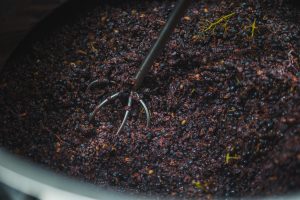
In our cellars at Château La Nerthe, it is the terroir that must be revealed. The winemaker himself steps back behind the mark of nature and the vintage. We thus intervene as little as possible in making our Châteauneuf-du-Pape wines. Instead, we let the 57 plots that make up our 92-hectare vineyard speak: a true mosaic of characters, enriched by a superb range of 13 grape varieties. The parcel-based vinification of our white wines, for example, accurately reflects this goal: their signature freshness mirrors the quality of our soils and the benign influence of our natural springs…
Aging, the Final Touch to Enhance Every Aromatic Expression
The bespoke aging of our wines also stems from our desire to maintain the delicate harmony between the soils, the plants, and human touch. In this way, aging is an extension of our commitment in our Châteauneuf-du-Pape vineyards, where we blend organic viticulture with agroecology, as well as our art of winemaking.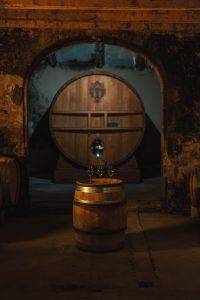
Moreover, to reveal the soul of the vintage and our terroirs, we primarily use large wood volumes, like our foudres and demi-muids. These noble containers are complemented by a few small tanks and barrels, housed in our 16th-century cellars.
Each of these decisions is crucial in preserving the identity of our wines. You can explore these choices in more detail during an exciting visit to our vineyard, accompanied by a tasting of our Châteauneuf-du-Pape…
Perpetuating the Legacy of Winemaking at Château La Nerthe
To us, winemaking is more than just a production step. It represents a fabulous wine heritage that we are keen to protect. The Ducos Cuvée is thus one of the symbols of our centuries-old expertise.
Joseph Ducos: A Major Inspiration for Our Work
 The Ducos Cuvée takes its name from Commander Joseph Ducos, who purchased Château La Nerthe in 1877 from the Tulle de Villefranche family. But at that time, the vineyard was devastated by phylloxera. Joseph Ducos devoted himself to finding a way to combat the parasitic aphid destroying all roots in its path. An eminent graduate of the Polytechnic, he decided to apply the work of the Montpellier School of Agriculture: he was thus the first to introduce grafted vines to Châteauneuf-du-Pape.
The Ducos Cuvée takes its name from Commander Joseph Ducos, who purchased Château La Nerthe in 1877 from the Tulle de Villefranche family. But at that time, the vineyard was devastated by phylloxera. Joseph Ducos devoted himself to finding a way to combat the parasitic aphid destroying all roots in its path. An eminent graduate of the Polytechnic, he decided to apply the work of the Montpellier School of Agriculture: he was thus the first to introduce grafted vines to Châteauneuf-du-Pape.
His perseverance was soon rewarded, and other regional winemakers quickly followed his successful example. Recognized by his peers, Joseph Ducos would later become mayor of the village of Châteauneuf-du-Pape, and then deputy of Vaucluse.
The Ducos Cuvée: A Tribute to Commander’s Winemaking Talents
Beyond his pivotal role in restoring our region’s vineyard, Joseph Ducos excelled in the art of winemaking. 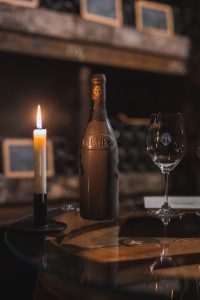
Specifically, one of his “recipes,” based on ten grape varieties, became so emblematic that it led to the selection of the thirteen grape varieties of the Châteauneuf-du-Pape appellation. Among these varieties are warm, mellow red grapes like Mourvèdre, Grenache, and Syrah, as well as elegant, fresh white grapes like Clairette and Picpoul.
The Ducos Cuvée is inspired by this iconic blend of wines. Our team crafts this experimental cuvée each year from the same ten Châteauneuf-du-Pape grape varieties. To continue passing down this tradition to future generations, the harvest is even pressed using a manual press, in the purest respect for the grape and our unique terroir…
Winemaking at Château La Nerthe, as well as aging, has always been the focus of our attention. This meticulous and patient care is something we invite you to experience if you visit Châteauneuf-du-Pape in winter: our team will then gladly guide you through our cellars and our history…
]]>
Agroecology and Viticulture: A Matter of Balance
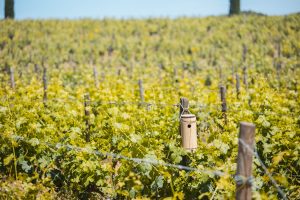 The definition of agroecology can be summarized as environmentally friendly production systems based on existing functionalities within the ecosystem. In this sense, agroecology requires a deep understanding of agronomy.
The definition of agroecology can be summarized as environmentally friendly production systems based on existing functionalities within the ecosystem. In this sense, agroecology requires a deep understanding of agronomy.
The French wine industry has been organizing for several years to promote an agroecological transition in the vineyards. The French Institute of Vine and Wine, in collaboration with the Ministry of Agriculture and INRA, has established seven main themes to be addressed providing a clear framework for estates that want to commit to more sustainable viticulture. Day by day, with passion and care, Château La Nerthe considers each of these in its vineyard.
Preserving the Quality of Unique Terroir Soils
 The vineyards of Château La Nerthe extend over remarkable terroirs within the Châteauneuf-du-Pape appellation. As the foundation of life in the vineyard, their soils must be protected. To prevent compaction, we work them thoughtfully, favoring tools that are as light as possible and limiting the frequency of mechanical intervention, such as plowing or weeding, known as griffonnage. We also establish plant cover composed of varied species chosen according to the needs of each plot.
The vineyards of Château La Nerthe extend over remarkable terroirs within the Châteauneuf-du-Pape appellation. As the foundation of life in the vineyard, their soils must be protected. To prevent compaction, we work them thoughtfully, favoring tools that are as light as possible and limiting the frequency of mechanical intervention, such as plowing or weeding, known as griffonnage. We also establish plant cover composed of varied species chosen according to the needs of each plot.
In addition, Marine Albert, our Vineyard Manager, promotes the regeneration of our wine-growing soils. Specifically, she combines fertilization and plant cover to improve soil structure, biological activity, and richness, among other benefits, thus optimizing the potential of our terroirs. Legumes are introduced into our plant cover: vetch, fava beans, peas, and clover. These plant families fix atmospheric nitrogen in the soil thus enriching it.
Finally, we work to limit the risks of water erosion, (meaning soil displacement during runoff), partly thanks to these plants which slow runoff and its impact. Water penetrates the soil more effectively along their roots, while soil particles aggregate around these same roots.
Protecting and Promoting Biodiversity in the Heart of the Vineyards
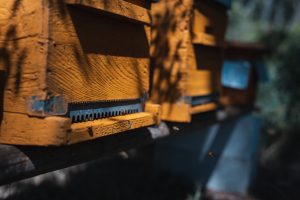 The fauna and flora populating the vineyards are an integral part of a precious ecosystem that Château La Nerthe cares for. Preserving this biodiversity allows us to strengthen our terroir and our identity.
The fauna and flora populating the vineyards are an integral part of a precious ecosystem that Château La Nerthe cares for. Preserving this biodiversity allows us to strengthen our terroir and our identity.
To contribute to the full flourishing of life, we use plant cover, cultivate grass in the vineyard rows, practice eco-grazing with sheep on our plots during winter, and plant forest hedges and fruit trees (fig, plum, hazelnut, etc.), prioritizing local varieties.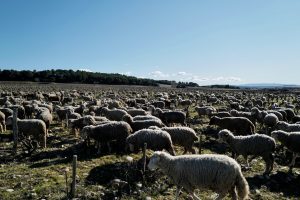
Within the plots, the landscape dimension of biodiversity is supported by the creation of ponds or integrating nesting boxes for blue tits, bats, and owls – a way to provide shelter for protected species in Châteauneuf-du-Pape. Bees are also at the center of our attention, with several beehives. To support these precious pollinators and participate in the protection of the environment, we sow honey flowers, as in our exceptional Cassagnes vineyard in the Côtes du Rhône.
Increasing the Use of Biocontrol in the Plots
 Château La Nerthe persistently adapts its farming practices based on observations and evolving techniques. Methods that reduce the use of insecticides guide our teams in the plots. Among them, sexual confusion or mating disruption is used to fight grapevine moths: pheromone diffusers placed on vine rows keep these pests away.
Château La Nerthe persistently adapts its farming practices based on observations and evolving techniques. Methods that reduce the use of insecticides guide our teams in the plots. Among them, sexual confusion or mating disruption is used to fight grapevine moths: pheromone diffusers placed on vine rows keep these pests away.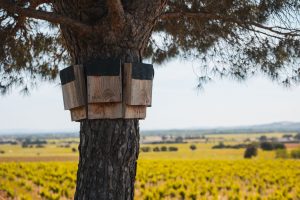
Biological control is another way we reduce the impact of certain pests. By introducing parasitoid insects onto our plots who thrive at the expense of grape enemies.
In addition to playing an essential role in protecting biodiversity, nesting boxes, hedges, and ponds scattered throughout our vineyard also have a regulatory effect as they are teeming with birds and small animals that feed on pests.
Ensuring Water Resource Preservation in the Vineyard
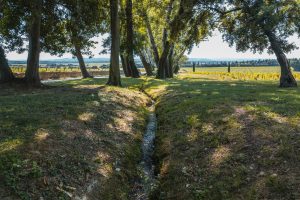 Year after year, the vineyards of Châteauneuf-du-Pape experience more intense and less frequent rains. Drought is thus at the forefront of tomorrow’s climate challenges, requiring resilient winemaking more than anything else.
Year after year, the vineyards of Châteauneuf-du-Pape experience more intense and less frequent rains. Drought is thus at the forefront of tomorrow’s climate challenges, requiring resilient winemaking more than anything else.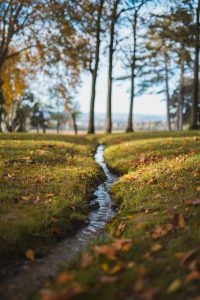
This is why Château La Nerthe is committed to adapting its vineyard to these new water constraints through several actions: proper soil preparation before planting, choosing plant material that is more tolerant to drought, thoughtfully managing the canopy to utilize the benefits of its foliage effectively, and reasoned and precise irrigation through water stress measurement.
In addition, we collect as much rainwater as possible around our plots, having built drains and water retention basins to allow heavy rains to be channeled, thus limiting erosion. Water that does not immediately penetrate the soil is stored in ponds or ditches lining the vineyard before slowly seeping into the ground.
Selecting Plant Material Suited to Agroecological Challenges
 Above all, we take into account the specificities of our terroirs’ soil and climate. Respect for pedoclimatic factors is critical to ensuring balanced viticulture and an accurate expression of the characteristics of our different appellations. You can discover these appelations during a visit to our vineyard.
Above all, we take into account the specificities of our terroirs’ soil and climate. Respect for pedoclimatic factors is critical to ensuring balanced viticulture and an accurate expression of the characteristics of our different appellations. You can discover these appelations during a visit to our vineyard.
The adaptation of plant material is also a lever to address tomorrow’s challenges. The plants in our new plantations come from a mass selection, with wide genetic diversity, for more resilience against diseases and pests.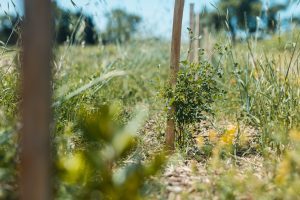
Our tree and forest hedge plantations are made from plant material taken from the natural areas surrounding our plots, ensuring successful establishment and cohabitation with the vineyard. We collaborate with a producer of wild plant materials who gathers and reproduces the most interesting plants from the surrounding areas, and we reintroduce them into our vineyard plots.
Adjusting Wine-Growing Practices to the Effects of Climate Change
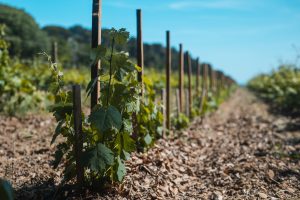 In the vineyard at Château La Nerthe we adapt each of our farming methods to new climate challenges. To reduce our carbon footprint, reasoned soil tillage allows us to limit the passage of tractors and the release of CO2 from the soil into the atmosphere.
In the vineyard at Château La Nerthe we adapt each of our farming methods to new climate challenges. To reduce our carbon footprint, reasoned soil tillage allows us to limit the passage of tractors and the release of CO2 from the soil into the atmosphere.
As for our choice of plant material, we prefer rootstocks that are more suitable to resist climate change and future droughts. And our plantations are composed of the region’s traditional grape varieties, which are more resilient to extreme temperatures.
Caring for Air and Atmosphere Quality
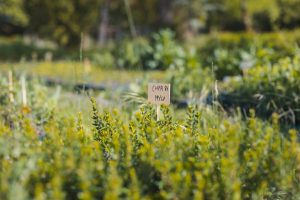 Château La Nerthe is committed to not burning any of its waste or plant residue (such as vine clippings). We also contribute to natural carbon sequestration by developing carbon sinks. We further increase carbon storage in the soil (by adding organic amendments, ground cover, mulch, and returning vine clippings to the soil) and biomass (by planting hedges and isolated trees).
Château La Nerthe is committed to not burning any of its waste or plant residue (such as vine clippings). We also contribute to natural carbon sequestration by developing carbon sinks. We further increase carbon storage in the soil (by adding organic amendments, ground cover, mulch, and returning vine clippings to the soil) and biomass (by planting hedges and isolated trees).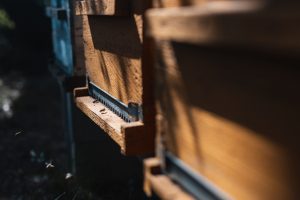
Furthermore, as part of our constant improvement efforts, we are currently studying the additional recommendations from the French Institute of Vine and Wine to protect air and atmospheric quality.
Through each of these numerous actions, viticulture and agroecology merge at the heart of Château La Nerthe’s philosophy. This sensitivity to nature contributes to a better balance of ecosystems and makes all the difference in bringing high-quality grapes to life, so we may continue crafting exceptional wines, faithful to five centuries of excellence.
]]>Château La Nerthe, an exceptional setting to enjoy the stunning winter landscapes of the Rhône Valley
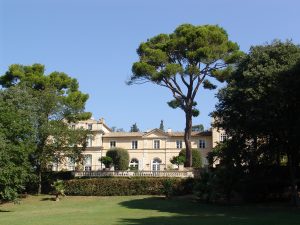
Imagine this. In the calm of winter, you leave the village of Châteauneuf-du-Pape heading south. In less than 2 km, you come upon an alley lined with cypresses, olive trees and holm oaks, before discovering a gorgeous park with magnificent plane trees and centuries-old pines. Nestled in the heart of this natural setting is the elegant 18th century residence of Château La Nerthe.
You will remember the view from its terrace for a long time, as it is unparalleled in the Vaucluse. A true belvedere, from where you can see the Rhône to the west and to the east the impressive Mont Ventoux, the emblematic summit of Provence. You can also admire the Châteauneuf-du-Pape vineyards below, especially those of our Clos de Beauvenir, or catch a glimpse of the ancient city of Popes in the distance.
And if you thought that our Rhone vineyard is motionless in the winter season, think again! During your visit, you may come across our winemakers busy pruning the vines. You will also learn about some of the Château’s commitments to biodiversity. You will be able to spot our nesting boxes designed to shelter chickadees, bats and owls when the temperatures drop, or meet some of our special guests: the sheep! Their grazing, mostly between January and March, enables the eco-friendly maintenance of the estate’s plots.
Several offers for tasting exceptional Castel-Papal wines, in the heart of historical cellars

After savoring this idyllic setting, you may want to warm up at bit. What perfect timing! Now it’s time to explore the estate’s cellars, where our bottles are stored, and immerse yourself in our know-how: a fascinating journey into five centuries of history, deeply intertwined with that of the village. To cater to different tastes, we offer guests 3 different visiting experiences, followed by Châteauneuf-du-Pape wine tastings.
- The “Discovery” Experience, with a 1-hour guided tour and a tasting of 5 of our wines, including the remarkable Cuvée des Cadettes.
- The “Terroir” Experience, with a 1:30 guided tour and the opportunity to discover 7 of our wines, including a rare old vintage, as well as the iconic Cuvée des Cadettes and Clos de Beauvenir in white.
- The “Passion” Experience, with a 2-hour private tour, including a candlelit tasting in our secret cellar, and a tasting with our sommelier featuring 8 wines from the Châteauneuf-du-Pape appellation. Among them, Les Clavelles, our most exclusive cuvée…
In short, these are privileged moments to be experienced over the weekend or while on vacation, or to be given to your loved ones in the form of gift certificates!
The surroundings are rich in activities to complete your winter visit to the cellars of Châteauneuf-du-Pape.
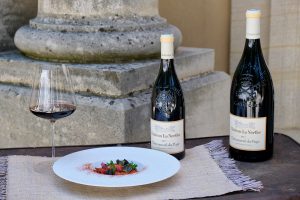
Thanks to the ideal location of Château La Nerthe, you can easily complete your itinerary, even in the coldest weather. After enjoying our wines, you can seek refuge in one of the delicious restaurants of Châteauneuf-du-Pape.
Among the best addresses in the area, there is the Hostellerie du Château des Fines Roches, a gastronomic restaurant that will surprise you with its incredible view of our estate. La Mère Germaine is also worth the trip, to either their Michelin-starred establishment or their bistro with its warm and friendly atmosphere. At the top of the village, Le Verger des Papes creatively reinterprets the terroir, while La Maisouneta and La Mule du Pape offer a cuisine that is both simple and refined.
Finally, for history buffs, the region is full of activities to do in the winter: on the one hand, you must visit Châteauneuf-du-Pape and its must-see tourist sites, such as the remains of the Palais des Papes and Notre-Dame de l’Assomption church. On the other hand, you can discover the magnificent Palais des Papes in Avignon (where we recommend the Michelin-starred restaurant La Mirande for lunch or dinner), or admire the Théâtre Antique and the Arc de Triomphe in Orange…
So, are you ready to explore our Châteauneuf-du-Pape cellar this winter? And if you are looking for inspiration for another weekend mixing wine and tourism, a visit to the Château de Corcelles vineyard in Beaujolais also promises an unforgettable day!
]]>This year we are proud to have six new talents on our team (from left to right): Charlotte Serve, Claire Commaille, Malaurie Lorentz, Pauline Comin, Elorine Baroni, and Chloé Fraisse.
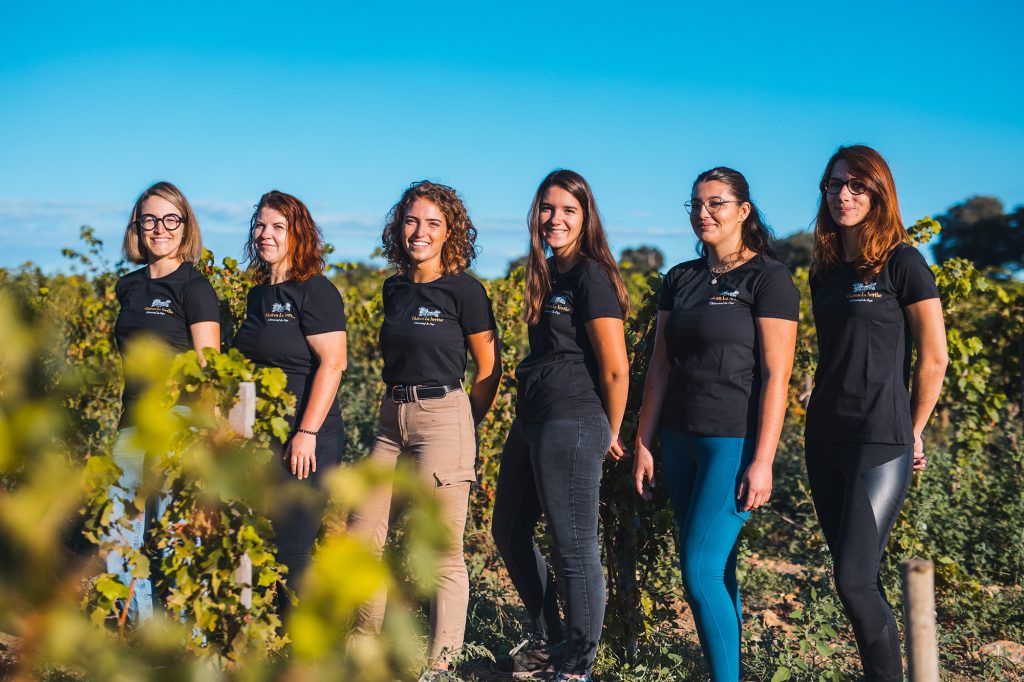
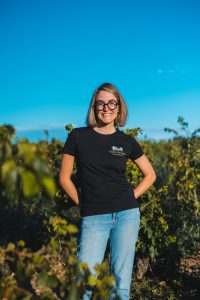
Charlotte Serve – 34 years old – Native of Rhone
During her ten years of experience in wine export in the USA, Charlotte had the opportunity to make wine in New Zealand, Burgundy, and the Loire Valley. In 2020 the Trump tax and Covid pushed her to switch to the technical side. She then undertook a National Professional Degree (BTS) in viticulture and enology to perfect her already well-advanced knowledge. She then realized her 4th vinification at Château La Nerthe before starting her training as a tractor driver with the ultimate goal of becoming a vineyard manager, then estate manager.
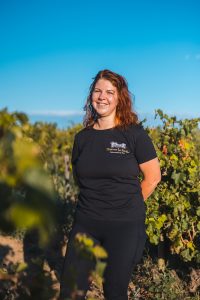
Claire Commaille – 33 years old – Native of Burgundy
Like Charlotte, Claire entered the world of wine through the commercial sector. After ten years of experience in export (English market) and with private customers, she decided to focus on the technical aspect that she has already had the opportunity to experience in several countries around the world: Australia, New Zealand, Germany, Italy, Portugal and in different French wine regions like Burgundy, Rhône, and the Loire. She has joined the Château La Nerthe team for the season before embarking on a National Professional Degree (BTS) in viticulture, enology, or Agricultural Company Management (BP REA), with plans to open her own wine estate.
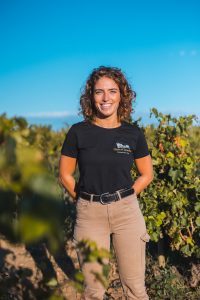
Malaurie Lorentz – 24 years old – Native of Alsace
After an Agri-food degree and a bachelor’s in chemistry, punctuated by several experiences in an enological analysis laboratory and cellars in Alsace and Bordeaux, Malorie validated her National Diploma in Oenology and joined the Château La Nerthe team. After the season, she will set sail for New Zealand before returning to the northern Rhone Valley, where she wants to specialize in viticulture and enology consulting.
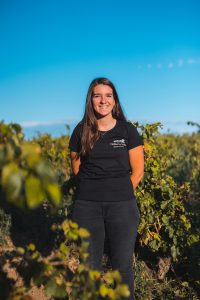
Pauline Comin – 24 years old – Native of Bordeaux
After a National Professional Degree (BTS) in agricultural, biological and biotechnological analysis with a minor in enology, Pauline joined the Bordeaux School of Agricultural Engineering specializing in viticulture and enology. She is currently completing her final internship at Château La Nerthe to complete her thesis on “decision-making tools,” aimed at reducing our environmental impact. She has also just obtained the National Diploma of Enology from Bordeaux. After the season, she would like to experience winemaking in the southern hemisphere.
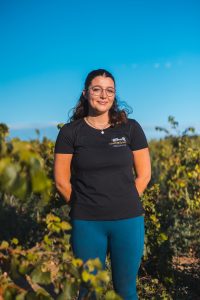
Elorine Baroni – 20 years old – Native of the southern Rhone Valley
A student at the Avignon Agribusiness Agronomy Engineering School, Elorine is doing a three-year work-study at Château La Nerthe. Her main mission is managing the CSR project, but she also assists in the cellar.

Chloé Fraisse – 27 years old – Native of Languedoc
Chloé started her career in medical social work and eventually headed for the world of wine. In parallel with her National Professional Diploma (BTS) in viticulture and enology, she completed her work-study as an employee of a wine estate, allowing her to gain experience in the technical space (viticulture and enology) as well as the administrative and commercial aspects of the business. After an additional experience in a wine estate focusing on the vine and the cellar, she joined the Château La Nerthe team for the 2022 vinifications. Her goal is to integrate an agricultural engineering school and experience the different wine regions of France and the world by juggling two annual vinifications between the southern and northern hemispheres, to then become a cellar master.
Our three vineyards in the Rhone Valley have had completely different harvests this year. Nevertheless, the summer heat and rain at the end of August and September meant that the berries were perfectly ripe on each property.
While the harvest at Château La Nerthe and Prieuré Montézargues were both less spread out over time than in previous years, those in our Côtes-du-Rhône vineyard “Les Cassagnes de La Nerthe” were scattered because of the rainy spells that animated this harvest season.
A hailstorm hit Château La Nerthe in the afternoon of August 14, which afflicted part of the Châteauneuf-du-Pape appellation. This event caused yield loss, which was significant depending on the plot. Fortunately, the mistral wind and hot temperatures quickly dried the affected berries, and we were able to start the harvest immediately, thanks to the early ripening from the scorching summer. The normal harvesting order was only slightly modified.
Cassagnes de La Nerthe vineyard resulted in a small and very qualitative crop. The white grape varieties developed quite early, as did the Grenache noir, whose harvest was closer than usual to that of the syrah. This year has been particularly favorable for our flagship Côtes-du-Rhône grape varieties, Grenaches blanc and noir.
In Tavel, at Prieuré de Montézargues, we have rarely had such a healthy and early harvest! We picked in the usual order, starting with the grenache blanc, then the grenache noir, cinsault, and syrah, and ending with grape varieties like clairette or bourboulenc, whose skin is more resistant to weather hazards. The berries are quite small and concentrated, and the quality is there!
The entire harvest promises exquisite wines, concentrated, fruity, and generous.
